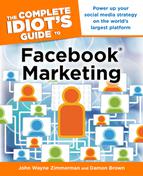What’s Missing in the Measurements?
You can access a lot of great data about your Facebook page, but some important details simply can’t be found in computer-generated reports.
This section helps you answer some tough marketing questions that you won’t find an answer to in any canned report.
One of the most frequently asked questions by businesses is this: Does Facebook marketing have a return on investment (ROI)? If so, how do you measure it? And how are other companies measuring it?
The reality of any marketing profit comes down to what was made minus what was the cost to make it. It’s fairly easy to get a handle on your expenses. In Facebook marketing, your costs may be your staff’s time, some consultant or agency time, and some advertising dollars.
Regarding revenue, these are the results that spurred from any actions taken on part of your Facebook marketing efforts. We like to think of revenue in terms of hard dollars and soft dollars:
• Hard dollars: Revenue you can track via specific links that you use within your campaigns, special codes, and exclusive Facebook-only offers.
• Soft dollars: The sales generated based on personal touch points that occur through engagement and interaction. Much like a sales person who is talking one-to-one to a client, how your Facebook page connects with users is hard to quantify, but we all know it’s important. It takes the right finesse, delivery, and cunning to close any deal with a customer.
FEEDBACK
Link-tracking websites like www.Bit.ly, www.Owl.ly, and many others enable you to type in a long URL, and this site will shorten the link and provide you with click-through statistics.
The ROI in hard dollar value is very real, and can and does happen all the time for companies that take the time to address Facebook marketing strategically. The ROI in soft dollar value is very real, too; however, it is difficult to quantify. You just have to trust that it’s there, working for you behind the scenes.
The following sections help you answer some other key questions.
How well is the competition doing?
If you’re BMW, how do you fare against Audi or Mercedes?
Most people would simply do a lookup on the number of fans and compare that total number. What you really need to do is go beyond fans and dive into which company has the most active fans from the right demographic who talk about your brand with a positive sentiment.
All Facebook, Skyttle Friends, and Social Bakers can help you dig further than any built-in tool that Facebook currently offers on its site to manage statistics.
Who are my top fans?
Victoria’s Secret has over 14,000,000 fans. But who are their biggest fans? Wouldn’t it be nice to know if you could pull out the top 5 percent who spend the most money per visit, are most active on their Facebook page, and are most likely to scream from their pink polka-dot panties that they love the brand?
You can determine these kinds of fan attributes by keeping track of all of your posts and recording/comparing the data to your current customer base. There is no automatic way to do this just yet, but you can do it manually.
What are my fans worth?
You might end up spending a sizeable investment your first year in Facebook marketing to get it right. With all that effort, can you put a price per fan?
You can calculate a price per fan by looking at the impressions generated in the News Feed and applying average ad pricing to the number of Facebook fans you have.
| FEEDBACK |
According to a new study by Virtue, the average Facebook fan is worth $3.60 in earned media.
How many of our fans have become customers?
You can always find out the answer to this question the hard way and implement tracking codes to every link you post on Facebook, and go into Google Analytics and review where links came from and if they followed the path all the way on your website from Facebook to Checkout on your site. But why not just ask them?
Use any of the following methods to verify if your customer is a Facebook fan:
• Simply ask them on your checkout form.
• Use the Question tool and ask people on your Wall.
• Pull a list of your customers and compare it to your fans.
How effective are my ad campaigns?
You may be running Google ads that push people to Facebook, or Facebook ads that push people to your site or Fan page. You can track all of these and, even more, the organic growth.
Nearly every question in this section can be answered if you integrate your Facebook marketing efforts with the rest of the organization. The key is to tie your data points and bring in different product owners and to track it all.
The Facebook Graph API also enables you to track many of these with just a little programming and creative flair for analytics.
